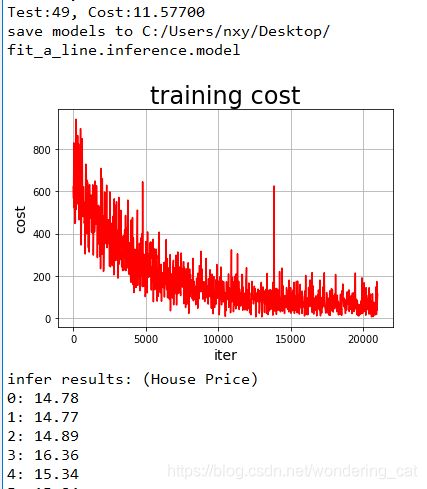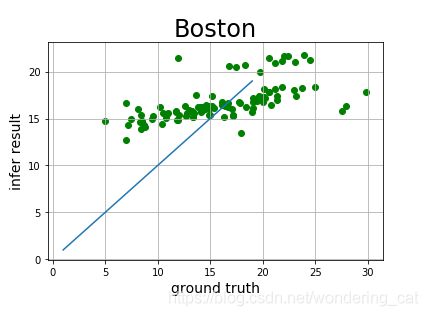深度学习(一):PaddlePaddle实现波士顿房价预测
一、PaddlePaddle安装
参考链接:https://blog.csdn.net/weixin_34117522/article/details/91869718
安装时可能会出现scipy、numpy等版本不匹配问题,原因是paddlepaddle要求版本与已经安装版本不匹配
pip install --target=F:\PaddlePaddle paddlepaddle
此命令默认安装paddlepaddle最新版本,可以指定paddlepaddle版本,我选择的是1.5.0版本:
pip install --target=F:\PaddlePaddle paddlepaddle==1.5.0
注意:paddlepaddle只能在安装目录下启动,否则会显示import paddle失败,所以要运行的.py文件直接存在其安装目录下。
二、波士顿房价预测
参考链接:1.房价预测代码及详解:https://aistudio.baidu.com/aistudio/projectdetail/79112
2.专业术语解释:https://www.jianshu.com/p/2946f75e3145
完整代码如下:
# -*- coding: utf-8 -*-
"""
Created on Sun Oct 13 23:40:56 2019
@author: nxy
"""
import paddle.fluid as fluid
import paddle
import numpy as np
import os
import matplotlib
matplotlib.use("Agg")
import matplotlib.pyplot as plt
BUF_SIZE=500
BATCH_SIZE=20
#paddle.reader.shuffle()表示每次缓存BUF_SIZE个数据项,并进行打乱
#paddle.batch()表示每BATCH_SIZE组成一个batch
#用于训练的数据提供器,每次从缓存中随机读取批次大小的数据
train_reader = paddle.batch(
paddle.reader.shuffle(paddle.dataset.uci_housing.train(), buf_size=BUF_SIZE),
batch_size=BATCH_SIZE)
#用于测试的数据提供器,每次从缓存中随机读取批次大小的数据
test_reader = paddle.batch(
paddle.reader.shuffle(paddle.dataset.uci_housing.test(),
buf_size=BUF_SIZE),
batch_size=BATCH_SIZE)
#用于打印,查看uci_housing数据
train_data=paddle.dataset.uci_housing.train();
sampledata=next(train_data())
print(sampledata)
#定义张量变量x,表示13维的特征值
x = fluid.layers.data(name='x', shape=[13], dtype='float32')
#定义张量y,表示目标值
y = fluid.layers.data(name='y', shape=[1], dtype='float32')
#定义一个简单的线性网络,连接输入和输出的全连接层
#input:输入tensor;
#size:该层输出单元的数目
#act:激活函数
y_predict=fluid.layers.fc(input=x,size=1,act=None)
#定义损失函数
#求一个batch的损失值,input=y_predict表示预测值,label=y表示实际值
cost = fluid.layers.square_error_cost(input=y_predict, label=y)
avg_cost = fluid.layers.mean(cost) #对损失值求平均值
#定义优化函数 使用随机梯度下降法SGD
optimizer = fluid.optimizer.SGDOptimizer(learning_rate=0.001)
opts = optimizer.minimize(avg_cost)
test_program = fluid.default_main_program().clone(for_test=True)
#use_cuda为False,表示运算场所为CPU;use_cuda为True,表示运算场所为GPU
use_cuda = False
place = fluid.CUDAPlace(0) if use_cuda else fluid.CPUPlace() #使用CPU运算
#创建一个Executor实例exe
exe = fluid.Executor(place)
#Executor的run()方法执行startup_program(),进行参数初始化
exe.run(fluid.default_startup_program())
# 定义输入数据维度 feed_list:向模型输入的变量表或变量表名
feeder = fluid.DataFeeder(place=place, feed_list=[x, y])
iter=0;
iters=[]
train_costs=[]
def draw_train_process(iters,train_costs):
title="training cost"
plt.title(title, fontsize=24)
plt.xlabel("iter", fontsize=14)
plt.ylabel("cost", fontsize=14)
plt.plot(iters, train_costs,color='red',label='training cost')
plt.grid()
plt.show()
#训练并保存模型
EPOCH_NUM=50
model_save_dir = "C:/Users/nxy/Desktop/fit_a_line.inference.model"
for pass_id in range(EPOCH_NUM): #训练EPOCH_NUM轮
# 开始训练并输出最后一个batch的损失值
train_cost = 0
for batch_id, data in enumerate(train_reader()): #遍历train_reader迭代器
train_cost = exe.run(program=fluid.default_main_program(),#运行主程序
#喂入一个batch的训练数据,根据feed_list和data提供的信息,将输入数据转成一种特殊的数据结构
feed=feeder.feed(data),
fetch_list=[avg_cost])
if batch_id % 40 == 0:
#打印最后一个batch的损失值
print("Pass:%d, Cost:%0.5f" % (pass_id, train_cost[0][0]))
iter=iter+BATCH_SIZE
iters.append(iter)
train_costs.append(train_cost[0][0])
# 开始测试并输出最后一个batch的损失值
test_cost = 0
for batch_id, data in enumerate(test_reader()): #遍历test_reader迭代器
test_cost= exe.run(program=test_program, #运行测试cheng
feed=feeder.feed(data), #喂入一个batch的测试数据
fetch_list=[avg_cost]) #fetch均方误差
#打印最后一个batch的损失值
print('Test:%d, Cost:%0.5f' % (pass_id, test_cost[0][0]))
#保存模型
# 如果保存路径不存在就创建
if not os.path.exists(model_save_dir):
os.makedirs(model_save_dir)
print ('save models to %s' % (model_save_dir))
#保存训练参数到指定路径中,构建一个专门用预测的program
fluid.io.save_inference_model(model_save_dir, #保存推理model的路径
['x'], #推理(inference)需要 feed 的数据
[y_predict],#保存推理(inference)结果的 Variables
exe) #exe 保存 inference model
draw_train_process(iters,train_costs)
#模型预测
infer_exe = fluid.Executor(place) #创建推测用的executor
inference_scope = fluid.core.Scope() #Scope指定作用域
#可视化真实值与预测值方法定义
infer_results=[]
groud_truths=[]
#绘制真实值和预测值对比图
def draw_infer_result(groud_truths,infer_results):
title='Boston'
plt.title(title, fontsize=24)
x = np.arange(1,20)
y = x
plt.plot(x, y)
plt.xlabel('ground truth', fontsize=14)
plt.ylabel('infer result', fontsize=14)
plt.scatter(groud_truths, infer_results,color='green',label='training cost')
plt.grid()
plt.show()
#开始预测
#修改全局/默认作用域(scope), 运行时中的所有变量都将分配给新的scope。
with fluid.scope_guard(inference_scope):
#从指定目录中加载 推理model(inference model)
[inference_program, #推理的program
feed_target_names, #需要在推理program中提供数据的变量名称
fetch_targets] = fluid.io.load_inference_model(#fetch_targets: 推断结果
model_save_dir, #model_save_dir:模型训练路径
infer_exe) #infer_exe: 预测用executor
#获取预测数据 #获取uci_housing的测试数据
infer_reader = paddle.batch(paddle.dataset.uci_housing.test(),
batch_size=200) #从测试数据中读取一个大小为200的batch数据
#从test_reader中分割x
test_data = next(infer_reader())
test_x = np.array([data[0] for data in test_data]).astype("float32")
test_y= np.array([data[1] for data in test_data]).astype("float32")
results = infer_exe.run(inference_program, #预测模型
feed={feed_target_names[0]: np.array(test_x)}, #喂入要预测的x值
fetch_list=fetch_targets) #得到推测结果
print("infer results: (House Price)")
for idx, val in enumerate(results[0]):
print("%d: %.2f" % (idx, val))
infer_results.append(val)
print("ground truth:")
for idx, val in enumerate(test_y):
print("%d: %.2f" % (idx, val))
groud_truths.append(val)
draw_infer_result(groud_truths,infer_results)
运行结果如下图:
显然,直线拟合还不够好,继续努力!!
文件运行第一次都正常,在同一个IPython下,运行第二次进程就会die掉,暂时没有找到解决办法,重新开一个进程就好了。


